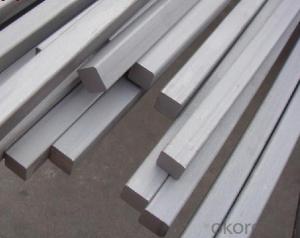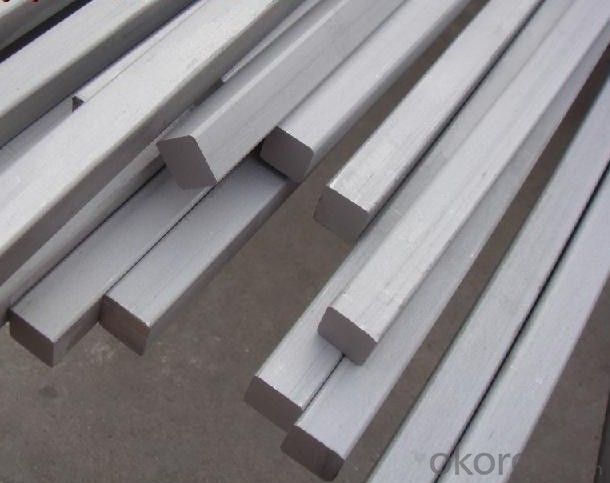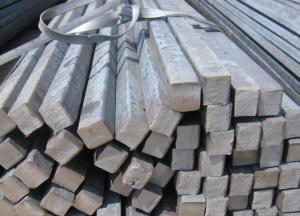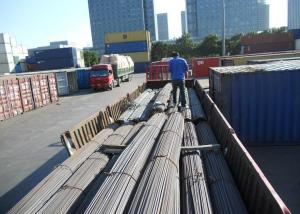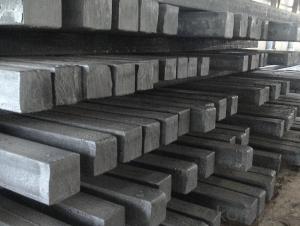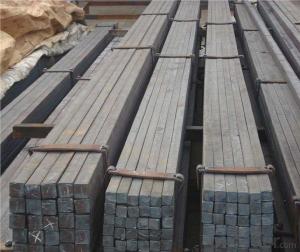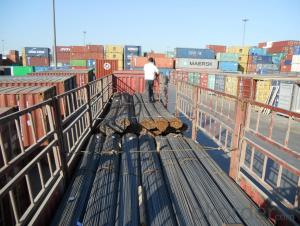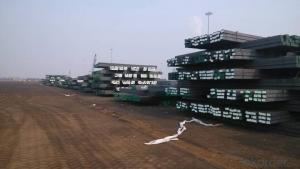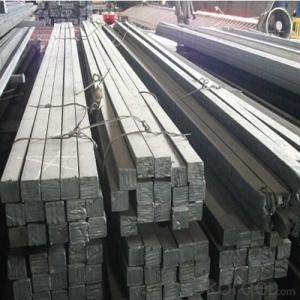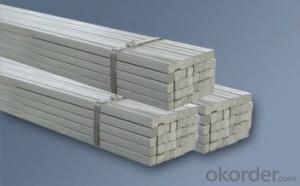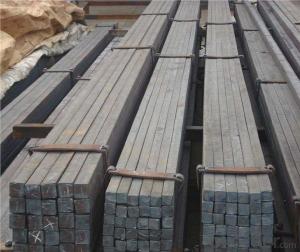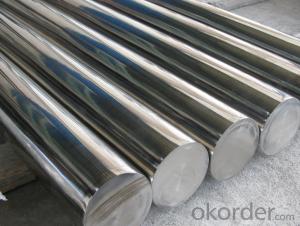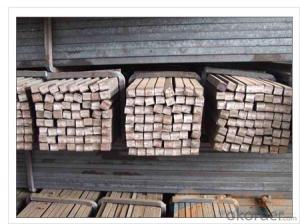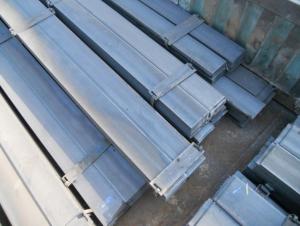Square Bar Steel with High Quality for Construction
- Loading Port:
- China main port
- Payment Terms:
- TT or LC
- Min Order Qty:
- 30 m.t.
- Supply Capability:
- 20000 m.t./month
OKorder Service Pledge
OKorder Financial Service
You Might Also Like
Product Description:
In the production of steel products, steel is molded and reshaped with different machinery at different temperatures. One process is steel rolling, which involves metal stock passing through a pair of rolls. Rolling produces flat steel sheets of a specific thickness, and the process is classified according to the temperature at which the metal is rolled. If the temperature of the metal is above its recrystallization temperature, or the temperature at which the grain structure of the metal can be altered, then the process is termed as hot rolling. If the temperature of the metal is below its recrystallization temperature, the process is termed as cold rolling.

Usage/Applications
-The Square Bar Steel with High Quality for Construction is normally used as structure steel.
-Row material for other structure steel like steel angles, channels, I-beams, H-beams, etc…
Packaging & Delivery
-Packing Detail: The products can be packed in bundles by steel wires.
-Marks: We make tag marks and color marks. The tag marks with white background and red company logo will be tied up to each bundle of the products. The information is usually including basic information of products and company and other information requested by customers. As for color marks, we will paint both ends of bundles to make sure that it w
-Delivery Detail: 30~45 working days after receive buyer’s T.T. or L/C.
ill be more convenient for customers to distinguish them from other products.
FAQ:
Q1: Why buy Materials & Equipment from OKorder.com?
A1: All products offered byOKorder.com are carefully selected from China's most reliable manufacturing enterprises. Through its ISO certifications, OKorder.com adheres to the highest standards and a commitment to supply chain safety and customer satisfaction.
Q2: How do we guarantee the quality of our products?
A2: We have established an advanced quality management system which conducts strict quality tests at every step, from raw materials to the final product. At the same time, we provide extensive follow-up service assurances as required.
Q3: How soon can we receive the product after purchase?
A3: Within three days of placing an order, we will begin production. The specific shipping date is dependent upon international and government factors, but is typically 7 to 10 workdays
Images:
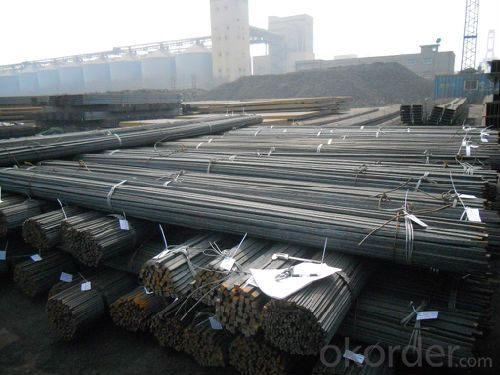
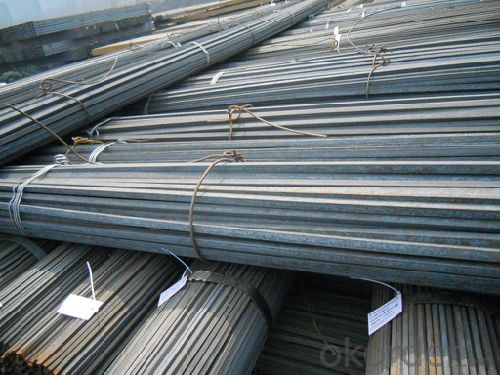
- Q: How do you store a steel square properly?
- To store a steel square properly, it is important to keep it in a dry and clean environment to prevent rusting. Place it in a protective case or wrap it in cloth to avoid scratches and damage. Additionally, store it in a location where it won't be subjected to excessive pressure or weight to maintain its accuracy.
- Q: How do you use a steel square to find the length of a board?
- To use a steel square to find the length of a board, follow these steps: 1. Begin by placing the steel square against one end of the board, ensuring that it is aligned properly with the edge. 2. Hold the steel square firmly in place, making sure it doesn't move during the measurements. 3. Look at the long side of the steel square, which is often referred to as the blade. It will have measurements marked on it. 4. Locate the inch markings on the blade and find the line that corresponds to the width of the board. For example, if the board is 6 inches wide, find the line labeled "6". 5. Once you have found the correct line, look at the short side of the steel square, called the tongue. It will have measurements marked on it as well. 6. Align the tongue with the edge of the board, ensuring that it is flush against the side. 7. While keeping the steel square and tongue in place against the board, extend the blade along the length of the board. 8. Now, observe the measurement marked on the blade where it aligns with the opposite end of the board. This measurement indicates the length of the board. 9. Take note of the measurement or use a pencil to mark it on the board for future reference. By using a steel square in this manner, you can accurately determine the length of a board, providing you with the necessary information for your woodworking or construction project.
- Q: Can a steel square be used for checking the squareness of a drill press quill?
- Checking the squareness of a drill press quill can be done using a steel square. This precision measuring tool has a right angle and can be utilized to determine if two surfaces or components are perpendicular. By placing the steel square against the quill and ensuring it is flush with both the quill and the base, one can visually inspect the quill's perpendicularity to the base. If the steel square meets both surfaces at a 90-degree angle, the quill is square. However, if there is a gap or the angle is not precisely 90 degrees, adjustments may be necessary to align the drill press quill correctly.
- Q: How do you use a steel square to create finger joints?
- To use a steel square to create finger joints, you will need a few essential tools and follow a step-by-step process. Here's how you can do it: 1. Gather the necessary tools: You will need a steel square, a marking knife or pencil, a chisel set, a mallet or hammer, and a workbench or sturdy surface. 2. Prepare the wood: Start by selecting the appropriate wood for your finger joints. Ensure it is flat and free from any defects. Cut the wood pieces to the desired length and width for your project. 3. Mark the wood: Use the steel square to mark the location and width of the finger joints on both pieces of wood. The square will help you create straight and accurate lines. Measure and mark the width of the fingers and the spaces in between. 4. Set the depth: Use the marking knife or pencil to score the marked lines on the wood. This step will help guide your chisel during the cutting process. Make sure the depth of the cuts matches the thickness of the adjoining piece of wood. 5. Chisel out the waste: Place the wood on a workbench or sturdy surface, ensuring it is secured in place. Use the chisel and mallet or hammer to carefully remove the waste wood between the scored lines. Start by making shallow cuts along the marked lines and gradually deepen the cuts until the waste is removed. 6. Test the fit: Once you have completed the cuts on one piece of wood, test the fit by inserting the fingers into the corresponding spaces of the adjoining wood piece. The joints should fit snugly without any gaps or looseness. If needed, make any necessary adjustments using the chisel until you achieve a perfect fit. 7. Glue and assemble: Apply a thin layer of wood glue to the joints and press the pieces together. Use clamps or other securing methods to hold the joint in place while the glue dries. Follow the manufacturer's instructions for the recommended drying time. 8. Final touches: Once the glue has dried, use sandpaper or a file to smooth out any rough edges or imperfections in the joint. This step will ensure a clean and professional finish. By following these steps and using a steel square as a guide, you can create precise and strong finger joints in your woodworking projects. Remember to practice caution and work slowly and carefully to achieve the best results.
- Q: How do you use a steel square to determine the angle of a molding cut?
- In order to determine the angle of a molding cut using a steel square, a few simple steps must be followed. Begin by ensuring that the steel square is clean and devoid of any debris or rust, as this will guarantee precise measurements. Next, position the square on the molding's edge, aligning one side of the square with the edge of the molding. Verify that the square is placed in a manner where the other side is perpendicular to the molding's edge. Once the square is appropriately positioned, locate the angle markings on the square. These markings are typically situated on the inside corner of the square, where the two arms meet. Now, carefully observe the angle measurement indicated on the square. This measurement will aid in determining the angle at which the molding needs to be cut. If the angle indicated on the square exceeds 90 degrees, it signifies the necessity for an obtuse angle cut. If the angle is less than 90 degrees, it denotes an acute angle cut. To execute the cut, transfer the angle measurement from the square to your saw or miter box. Set the saw or miter box to the desired angle and meticulously cut the molding along the marked line. Always remember to wear appropriate safety gear, such as goggles and gloves, when working with tools and sharp objects. Prior to making any cuts, double-check your measurements and angle settings to ensure accuracy and precision.
- Q: How do you use a steel square to measure angles?
- To use a steel square for measuring angles, you can follow these steps: 1. Ensure that the steel square is clean and free from any dirt or debris that may affect the accuracy of your measurements. 2. Identify the angle that you want to measure. The steel square typically has two arms, a longer one called the blade and a shorter one called the tongue. 3. Place the steel square on a flat surface, ensuring that the blade is aligned with one side of the angle you want to measure. 4. Rotate the square until the tongue aligns with the other side of the angle. Make sure that both arms of the square are in contact with the surface and the sides of the angle. 5. Once the steel square is properly aligned, read the angle measurement from the scale engraved on the blade or tongue. The scale usually provides measurements in degrees, with markings at regular intervals. 6. Take note of the angle measurement and record it for future reference or use. It is important to handle the steel square with care to avoid any damage that might affect the accuracy of its measurements. Regularly check and calibrate your steel square if necessary to ensure precise and reliable angle measurements.
- Q: How do you use a steel square to determine the height of an object?
- To determine the height of an object using a steel square, follow these steps: 1. Ensure the steel square is level and stable by placing it on a flat surface. 2. Position the object you want to measure next to the steel square. 3. Vertically align the long side of the steel square with the side of the object, ensuring it is flush against the object's surface. 4. Observe the measurement markings on the steel square. The point where the top edge of the object intersects with the measurement scale on the square indicates the object's height. 5. Take note of the measurement indicated on the steel square, as it represents the object's height. Please note that if the object has an irregular shape or is not flat, you may need to adjust your positioning to find a consistent reference point for measurement. Additionally, accuracy in calibration and readability of the steel square's measurements are crucial for obtaining precise results.
- Q: How is a steel square different from a combination square?
- A steel square and a combination square are both measuring tools used in carpentry and metalworking, but they have different features and purposes. A steel square, also known as a framing square or carpenter's square, is a large, L-shaped tool typically made of steel or aluminum. It has two arms, one longer than the other, and is primarily used for measuring and marking right angles. The longer arm, known as the blade, is usually 24 inches long, while the shorter arm, called the tongue, is typically around 16 inches. Steel squares are commonly used in construction for tasks like framing, laying out stairs, and checking for squareness. On the other hand, a combination square is a versatile measuring tool that consists of a ruler or blade with an adjustable head that can be locked at different angles. The head of a combination square has a level bubble, a protractor scale, and a scribe or marking point. Unlike a steel square, a combination square allows for precise measurements, including both angles and lengths. It is commonly used in woodworking, metalworking, and other trades where accuracy and versatility are important. Combination squares are useful for tasks such as measuring and marking 45-degree and 90-degree angles, setting up miter cuts, and transferring measurements. In summary, the main difference between a steel square and a combination square lies in their design and functionality. A steel square is a simple L-shaped tool primarily used for measuring right angles, while a combination square is a more sophisticated measuring tool that can measure angles and lengths with greater precision and versatility.
- Q: Can a steel square be used for beam layout and construction?
- For beam layout and construction purposes, a steel square proves to be quite useful. Known by various names such as framing square or carpenter's square, this versatile tool is commonly employed in the fields of carpentry and construction. It comprises of a lengthy, straight edge and a comparatively shorter, perpendicular edge that creates a perfect right angle. When it comes to beam layout and construction, a steel square enables marking and measuring of angles and lengths, ensuring precise placement of beams. It assists in determining the appropriate cutting angles for beams and guarantees proper alignment and levelness during the construction process. Furthermore, a steel square serves the purpose of checking for squareness, ensuring that the corners of the beams are at accurate 90-degree angles. This aspect holds great significance in terms of structural integrity and stability. In conclusion, a steel square offers immense value for beam layout and construction due to its ability to deliver accuracy, versatility, and user-friendliness.
- Q: Can a steel square be used as a makeshift protractor?
- Using a steel square as a makeshift protractor is not possible. Despite their shared purpose of measuring angles, these tools have distinct functions and designs. A steel square is primarily employed for creating right angles and gauging straight edges, whereas a protractor is exclusively crafted for measuring angles of any magnitude. The markings and scale on a steel square lack precision when measuring non-right angles. Opting for the appropriate tools is always the best approach in achieving accurate measurements.
Send your message to us
Square Bar Steel with High Quality for Construction
- Loading Port:
- China main port
- Payment Terms:
- TT or LC
- Min Order Qty:
- 30 m.t.
- Supply Capability:
- 20000 m.t./month
OKorder Service Pledge
OKorder Financial Service
Similar products
Hot products
Hot Searches
Related keywords
